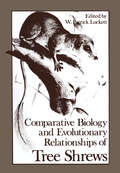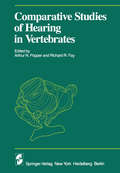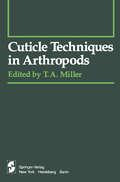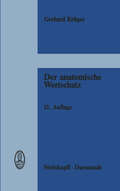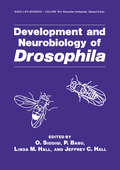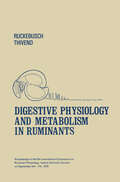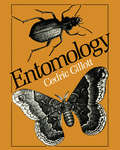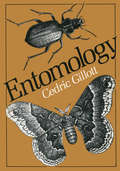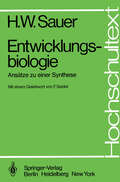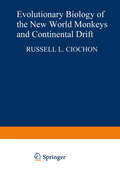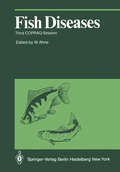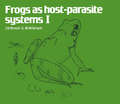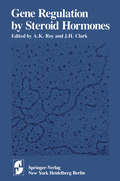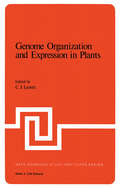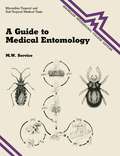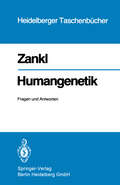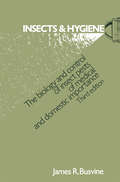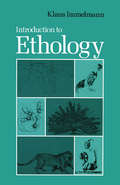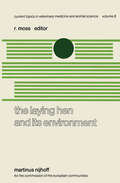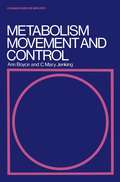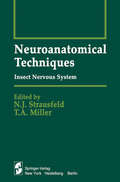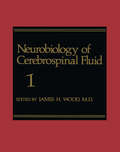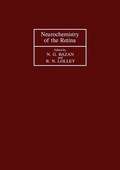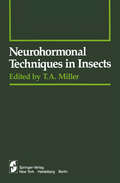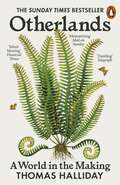- Table View
- List View
Comparative Biology and Evolutionary Relationships of Tree Shrews (Advances in Primatology)
by W. Patrick LuckettTree shrews are small-bodied, scansorial, squirrel-like mammals that occupy a wide range of arboreal, semi-arboreal, and forest floor niches in Southeast Asia and adjacent islands. Comparative aspects of tree shrew biology have been the subject of extensive investigations during the past two decades. These studies were initiated in part because of the widely accepted belief that tupaiids are primitive primates, and, as such, might provide valuable insight into the evolutionary origin of complex patterns of primate behavior, locomotion, neurobiology, and reproduction. During the same period, there has been a renewed interest in the methodology of phylogenetic reconstruction and in the use of data from a variety of biological disciplines to test or formulate hypotheses of evolutionary relationships. In particular, interest in the com parative and systematic biology of mammals has focused on analysis of phy logenetic relationships among Primates and a search for their closest relatives. Assessment of the possible primate affinities of tree shrews has comprised an important part of these studies, and a considerable amount of dental, cranio skeletal, neuroanatomical, reproductive, developmental, and molecular evi dence has been marshalled to either corroborate or refute hypotheses of a special tupaiid-primate relationship. These contrasting viewpoints have re sulted from differing interpretations of the basic data, as well as alternative approaches to the evolutionary analysis of data.
Comparative Studies of Hearing in Vertebrates (Proceedings in Life Sciences)
by A. N. Popper R. R. FayThe past two decades have seen an extraordinary growth of interest in the auditory mechanisms of a wide range of vertebrates and invertebrates. Investigations have ranged from auditory mechanisms in relatively simple animals where just a few cells are em ployed for detection of sound, to the highly complex detection and processing systems of man and the other mammals. Of particular significance to us has been the growing interest in general principles of vertebrate auditory system organization, as opposed to a specific and limited concern for the mammalian or even human systems. Some of the interest in nonmammalian systems has risen from the desire to fmd simpler experi mental models for both the essential components (e. g. , the hair cell receptor) and the more complex functions (e. g. , frequency analysis) of all vertebrate auditory systems. Interest has also risen from questions about the evolution of hearing and the covariation (or lack of it) in structure and function in a wide variety of biological solutions to the problems of acoustic mechanoreception. Of course, the desire to fmd simpler experi mental models and the need to answer questions about the evolution of hearing are not unrelated. In fact, detailed analyses of a variety of systems have led several times to the realization that some of the "simple systems" are more complex than initially thought.
Cuticle Techniques in Arthropods (Springer Series in Experimental Entomology)
by A. G. Richards T. A. MillerInsects as a group occupy a middle ground in the biosphere between bac teria and viruses at one extreme, amphibians and mammals at the other. The size and general nature of insects present special problems to the student of entomology. For example, many commercially available in struments are geared to measure in grams, while the forces commonly en countered in studying insects are in the milligram range. Therefore, tech niques developed in the study of insects or in those fields concerned with the control of insect pests are often unique. Methods for measuring things are common to all sciences. Advances sometimes depend more on how something was done than on what was measured; indeed a given field often progresses from one technique to another as new methods are discovered, developed, and modified. Just as often, some of these techniques find their way into the classroom when the problems involved have been sufficiently ironed out to permit students to master the manipulations in a few laboratory periods. Many specialized techniques are confined to one specific research labo ratory. Although methods may be considered commonplace where they are used, in another context even the simplest procedures may save con siderable time. It is the purpose of this series (1) to report new develop ments in methodology, (2) to reveal sources of groups who have dealt with and solved particular entomological problems, and (3) to describe ex periments which might be applicable for use in biology laboratory courses.
Der anatomische Wortschatz: unter Mitberücksichtigung der Histologie und der Embryologie für Studierende, Ärzte und Tierärzte
by G. KrügerDevelopment and Neurobiology of Drosophila: (pdf) (Basic Life Sciences #16)
by O. Siddiqi P. Babu Linda M. Hall Jeffrey C. HallDigestive Physiology and Metabolism in Ruminants: Proceedings of the 5th International Symposium on Ruminant Physiology, held at Clermont — Ferrand, on 3rd–7th September, 1979
by Y. Ruckebusch P. ThivendTwo questions could not be avoided in the avant-propos of this book; (i) what is the importance to man of ruminant livestock, and (ii) what results of practical relevance in the growing mountain of scientific verbiage could be found in the Proceedings of this Symposium. Herbivores are an integral and critical part of the natural ecosystem which must be preserved because of their impact on human welfare. Wh at makes ruminants especially important to man is that they can thrive on fibrous forage and are thus the only viable enterprise over much of the earth's surface where crop growing is impracti cable. They contribute a wide array of products in addition to 50000 000 tonnes ofmeat (1977) and represent a 'capital reserve' that can be drawn upon in times of emergency: milk for example (450000000 tonnes) can make the difference between subsistence and starvation. About 60% of the world's meat and 80 % of the milk are produced by one third of the world ruminant population in the developed regions and as much as 99 % of the power for agriculture is provided by the ruminant population in developing countries. For the next two decades, a probable increase by 30 % for . cattle and buffalo and more than 40 % for sheep and goats is expected by improving health, fertility, nutrition and genetic potential rather than feed resources.
Entomology
by Cedric GillottThe idea of writing this book was conceived when, in the late 1960s, I began teaching a senior undergraduate class in general entomology. I soon realized that there was no suitable text for the class I intended to give. The so-called "general" or "introductory" texts reflected the traditional taxonomic approach to entomology and contained relatively little information on the physiology and ecology of insects. This does not mean that there were no books containing such information. There were several, but these were so specialized and de tailed that their use in an introductory class was limited. I hold a strong belief that an undergraduate general entomology course should provide a balanced treatment of the subject. Thus, although some time should be devoted to taxonomy, including identification (best done in the laboratory, using primar ily material which students themselves have collected, supplemented with specimens from the general collection), appropriate time should be given also to discussion of the evolution, development, physiology, and ecology of in sects. In the latter category I include the interactions between insects and Man because it is important to stress that these interactions follow normal ecological principles. Naturally, the format of this book reflects this belief. The book has been arranged in four sections, each of which necessarily overlaps with the others.
Entomology
by Cedric GillotThe idea of writing this book was conceived when, in the late 1960s, I began teaching a senior undergraduate class in general entomology. I soon realized that there was no suitable text for the class I intended to give. The so-called "general" or "introductory" texts reflected the traditional taxonomic approach to entomology and contained relatively little information on the physiology and ecology of insects. This does not mean that there were no books containing such information. There were several, but these were so specialized and de tailed that their use in an introductory class was limited. I hold a strong belief that an undergraduate general entomology course should provide a balanced treatment of the subject. Thus, although some time should be devoted to taxonomy, including identification (best done in the laboratory, using primar ily material which students themselves have collected, supplemented with specimens from the general collection), appropriate time should be given also to discussion of the evolution, development, physiology, and ecology of in sects. In the latter category I include the interactions between insects and Man because it is important to stress that these interactions follow normal ecological principles. Naturally, the format of this book reflects this belief. The book has been arranged in four sections, each of which necessarily overlaps with the others.
Evolutionary Biology of the New World Monkeys and Continental Drift (Advances in Primatology)
by Russell L. CiochonIt is now well known that the concept of drifting continents became an estab lished theory during the 1960s. Not long after this "revolution in the earth sciences," researchers began applying the continental drift model to problems in historical biogeography. One such problem was the origin and dispersal of the New World monkeys, the Platyrrhini. Our interests in this subject began in the late 1960s on different conti nents quite independent of one another in the cities of Florence, Italy, and Berkeley, California. In Florence in 1968, A. B. Chiarelli, through stimulating discussions with R. von Koenigswald and B. de Boer, became intrigued with the possibility that a repositioning of the continents of Africa and South America in the early Cenozoic might alter previous traditional conceptions of a North American origin of the Platyrrhini. During the early 1970s this con cept was expanded and pursued by him through discussions with students while serving as visiting professor at the University of Toronto. By this time, publication of the Journal of Human Evolution was well underway, and Dr. Chiarelli as editor encouraged a dialogue emphasizing continental drift models of primate origins which culminated in a series of articles published in that journal during 1974-75. In early 1970, while attending the University of California at Berkeley, R. L. Ciochon was introduced to the concept of continental drift and plate tectonics and their concomitant applications to vertebrate evolution through talks with paleontologist W. A. Clemens and anthropologist S. L. Washburn.
Gene Regulation by Steroid Hormones
by A. K. Roy J. H. ClarkWithin the last two decades endocrinological research has taken a definite tum toward biochemistry and molecular biology. This has resulted in a new discipline called' 'molecular endocrinology. " Studies on the mechanism of hormone action have continued to make headlines with fundamental discov eries in receptor action and gene regulation. Recently the insect endocrino logists have also begun to explore the molecular mechanism of steroid hor mone action taking advantage of the vast number of Drosophila mutants, the library of Drosophila gene, and several well-characterized cell-lines. The availability ofthe recombinant DNA technology has provided a truly revolu tionary tool in the hands of the molecular endocrinologists. "Gene Regula tion by Steroid Hormones" is compiled and presented in this frontier spirit, and we hope that this volume will serve not only the active investigators in the field but will also be very useful to students and researchers with a gen eral interest in regulatory biology. The book is an offshoot of the Conference on Molecular Mechanism of Steroid Hormone Action held at the Meadow Brook Mansion of Oakland University in the fall of 1978. We wish to acknowledge the financial assist ance from the National Science Foundation and Oakland University. The conferees will never forget the warmest hospitality of Dr. LOWELL EKLUND and his staff at the Meadow Brook center and we also wish to express per sonal gratitude to many of our students and colleagues for helping us to make the conference a great success.
Genome Organization and Expression in Plants (Nato ASI Subseries A: #29)
by C. LeaverIn the summer of 1976 a successful workshop on nucleic acids and protein synthesis in plant systems was organised in Strasbourg by Jacques Weil and Lawrence Bogorad. The participants in the workshop, were, without exception, excited both by the quality of the work discussed and by the rapid progress being made in several areas of genomic analysis and expression in plants. It also became apparent that there was a need for an international assembly of this sort at regular intervals. These workshops not only encourage stim ulating discussion and constructive thinking but also result in increased collaboration and productive liaison between laboratories with common interests. Hence a ten-day advanced studies institute course was organised in Edinburgh from 11-21 July 1979, and in this volume we have published the contributions given by the invited speakers. The subjects discussed covered most areas of plant molecular biology and the lecturers were asked to balance a review of their chosen subject with the results of their own recent research and likely future advances. Probably the most important technical advance since the previous meeting of this group in Strasbourg, was the application of restriction enzyme analysis and cloning techniques. This is illustrated in many of the published lectures and was the basis for many of the more informal discussion sessions.
Humangenetik: Fragen und Antworten (Heidelberger Taschenbücher #207)
by Heinrich ZanklDie Humangenetik gehört zu den "kleinen Fächern", denen die Medizinstudenten bei ihrer Vorbereitung auf den 1. Abschnitt der ärztlichen Prüfung bisher nur wenig Beachtung geschenkt haben. Durch die Verschärfung der Prüfungsbedingungen ist es jedoch not wendig geworden, sich auch auf dieses Fach intensiv vorzubereiten. Da es nicht möglich ist, kurz vor der Prüfung ganze Lehrbücher durchzuarbeiten, erschien es sinnvoll, einen Text zur Verfügung zu stellen, der ohne großen Zeitaufwand mit den für die Prüfung wichtigsten Themen vertraut macht. Das vorliegende Büchlein ist aus einem Seminar für Prüfungskandidaten hervorgegangen, das sich bei den Studenten großer Beliebtheit erfreut. Durch die Orientierung des Textes an einzelnen Fragen hat der Student Gelegenheit, die Prüfungssituation zu simulieren und sein Wissen zu kontrollieren. Die Antworten wurden so umfassend gestaltet, daß klar wird, warum eine bestimmte Antwort richtig ist und daß auch andere Fragen zum gleichen Themenkreis beantwortet werden können. Soweit notwen dig, wurde auch auf Unklarheiten und bewußte Fallen in der Fragestellung hingewiesen, um den Blick der Studenten für solche Prüfungserschwernisse zu schärfen.
Insects and Hygiene: The biology and control of insect pests of medical and domestic importance
by James Ronald BusvineIt was gratifying to be invited to prepare a third edition of this book, which first appeared in 1951. Preliminary discussions with the publishers, however, revealed a considerable challenge in the present high costs of printing, so that changes and some improvements were clearly necessary to justify the venture. It was immediately apparent that the chapter on chemical control measures would have to be substantially re-written, because of the great changes in usage due to resistance and the regulations introduced to prevent environmental pollution. Also, I decided to expand the scope of the book by increased coverage of the pests of continental Europe and North America, including some new figures and keys in the Appendix. These two undertakings resulted in considerable expansion in length, with about 370 new references and 250 additional specific names in the Index. In order to avoid too alarming an increase in price, I decided to sacrifice three chapters from the earlier editions: those dealing with the structure and classification of insects, their anatomy and physiology, and their ecology. Readers who require basic biological information on insects should buy one of the various short introductions to entomology available.
Introduction to Ethology
by Klaus ImmelmannEthology, the study of the biology of behavior, has grown tremendously during the last few decades. The large number of accumulated facts is difficult to survey, understanding and an appreciation of the ethological approach to the study of behavior have grown, and the number of attempts at holistic explanations for certain behavioral phenomena has increased. Because of this development it has become more difficult to gain an overview of the field, to keep up with new developments, and to update the subject matter by the inclusion of new facts in the proper place. The nonspecialist is unable to evaluate the more general statements in the popular literature, especially when such works are aimed at a broader audience. Hence, this book has a dual purpose: (1) to lend some order to the dizzying array of information and thus simplify inquiry into ethology; and (2) to present relevant facts and knowledge that will help the reader confronted with numerous studies and articles in the ethological literature.
The Laying Hen and its Environment: A Seminar in the EEC Programme of Coordination of Research on Animal Welfare, organised by R. Moss and V. Fischbach, and held at Luxembourg, March 11–13, 1980 (Current Topics in Veterinary Medicine #8)
by R. MossThe welfare of domestic poultry. particularly those kept under intensive housing conditions is a subject ~n which many. often divergent and conflicting views. are held. This divergence, may be the result either of insufficient knowledge of the facts of particular poultry husbandry systems or a differing interpretation of those facts. With regard to poultry and the laying hen in particular. there is a need to gather together a basic knowledge of avian behaviour in all the circumstances and systems of husbandry under which birds are presently being kept. That knowledge should lead to the development of interpretative and hopefully predictive theories which in turn will allow us to meet the recommendations of Article 3 of the Council of Europe Convention on the Protection of Animals Kept for Farming Purposes: 'that animals shall be housed, provided with food. water and care in a manner which - having regard to their species and to their degree of development. adaptation and domestication - is appropriate to their physiological and ethological needs in accordance with established experience and scientific knowledge'. In furtherance of those objectives a small group of specialists in poultry physiology and ethology. both from within and outside the European Community met by invitation of the Commission in Luxembourg between 11 and 13 March 1980. Their objective was to discuss what is already known. and can be agreed on. of the normal physiology and ethological range of the laying hen.
Neuroanatomical Techniques: Insect Nervous System (Springer Series in Experimental Entomology)
by J. S. AltmanMost neurobiological research is performed on vertebrates, and it is only natural that most texts describing neuroanatomical methods refer almost exclusively to this Phylum. Nevertheless, in recent years insects have been studied intensively and are becoming even more popular in some areas of research. They have advantages over vertebrates with respect to studying genetics of neuronal development and with respect to studying many aspects of integration by uniquely identifiable nerve cells. Insect central nervous system is characterized by its compactness and the rather large number of nerve cells in a structure so small. But despite their size, parts of the insect eNS bear structural comparisons with parts of vertebrate eNS. This applies particularly to the organization of the thoracic ganglia (and spinal cord), to the insect and vertebrate visual sys tems and, possibly, to parts of the olfactory neuropils. The neurons that make up these areas in insects are often large enough to be impaled by microelectrodes and can be injected with dyes. Added to advantages of using a small eNS, into which the sensory periphery is precisely mapped, are the many aspects of insect behaviour whose components can be quan titized and which may find both structural and functional correlates within clearly defined regions of neuropil. Together, these various features make the insect eNS a rewarding object for study. This volume is the first of two that describe both classic and recent methods for neuroanatomical research on insect eNS.
Neurobiology of Cerebrospinal Fluid 1
by James H. WoodPhysiologic compartmentalization effectively isolates the central nervous system from the rest of the body. This isolation not only provides protection of its delicate function from aberrant peripheral influences but also impedes its diagnostic evaluation. Cerebro spinal fluid (CSF) bathes the brain and spinal cord, is in dynamic equilibrium with its extracellular fluid, and tends to reflect the state of health and activity of the central nervous system. CSF examination is the most direct and popular method of assessing the central chemical and cellular environment in the living patient or mammal. The purpose of this multidisciplined reference text is to provide the sophisticated knowledge of CSF physiology and pathology necessary for the meaningful interpretation of data obtained by various types of CSF analysis. The methodology for reliable CSF collection, storage, preparation, and analysis is discussed with respect to individual, somatotropic, chronologic, endorcinologic, pharmacologic, and possible artifactual var iations in CSF composition. These essential aspects, which ensure the validity of CSF data, are presented to aid the investigator in clinical and experimental protocol formu lation and in elimination of possible sources of error.
Neurochemistry of the Retina: Proceedings of the International Symposium on the Neurochemistry of the Retina Held in Athens, Greece, August 28 - September 1, 1979
by NICOLAS G. BAZAN, RICHARD N. LOLLEYNeurochemistry of the Retina covers the proceedings of the International Symposium on the Neurochemistry of the Retina held in Athens, Greece, on August 28 – September 1, 1979. This book mainly focuses on the retina and its neurochemistry. This text is divided into eight major parts. The first part discusses the composition, metabolism, and biogenesis of membrane components. This book then explains the biochemical approaches to the study of visual cells and their relationship with the pigment epithelium, photorector shedding, and circadian rhythm. Chemical transmission of nerve signals is also tackled. This text also looks into the biochemical aspects of photoreceptor structure and function; cyclic nucleotides; and biochemical and pharmacological approaches to study the entire retina. This book concludes by explaining the neurochemical studies in retinal diseases and future research and prospective of the subject. This publication will be invaluable to ophthalmologists and students of ophthalmology.
Neurohormonal Techniques in Insects (Springer Series in Experimental Entomology)
by G. S. Fraenkel T. A. MillerInsects as a group occupy a middle ground in the biosphere between bac teria and viruses at one extreme, amphibians and mammals at the other. The size and general nature of insects present special problems to the student of entomology. For example, many commercially available in struments are geared to measure in grams, while the forces commonly en countered in studying insects are in the milligram range. Therefore, tech the study of insects or in those fields concerned with niques developed in the control of insect pests are often unique. Methods for measuring things are common to all sciences. Advances sometimes depend more on how something was done than on what was measured; indeed a given field often progresses from one technique to another as new methods are discovered, developed, and modified. Just as often, some of these techniques find their way into the classroom when the problems involved have been sufficiently ironed out to permit students to master the manipulations in a few laboratory periods. Many specialized techniques are confined to one specific research labo ratory. Although methods may be considered commonplace where they are used, in another context even the simplest procedures may save con siderable time. It is the purpose of this series (1) to report new develop ments in methodology, (2) to reveal sources of groups who have dealt with and solved particular entomological problems, and (3) to describe ex periments which might be applicable for use in biology laboratory courses.
Otherlands: A World in the Making
by Thomas Halliday'The best book on the history of life on Earth I have ever read' Tom Holland'Epically cinematic... A book of almost unimaginable riches' Sunday TimesThis is the past as we've never seen it before. Otherlands is an epic, exhilarating journey into deep time, showing us the Earth as it used to exist, and the worlds that were here before ours. Travelling back in time to the dawn of complex life, and across all seven continents, award-winning young palaeobiologist Thomas Halliday gives us a mesmerizing up close encounter with eras that are normally unimaginably distant. Halliday immerses us in a series of ancient landscapes, from the mammoth steppe in Ice Age Alaska to the lush rainforests of Eocene Antarctica, with its colonies of giant penguins, to Ediacaran Australia, where the moon is far brighter than ours today. We visit the birthplace of humanity; we hear the crashing of the highest waterfall the Earth has ever known; and we watch as life emerges again after the asteroid hits, and the age of the mammal dawns. These lost worlds seem fantastical and yet every description - whether the colour of a beetle's shell, the rhythm of pterosaurs in flight or the lingering smell of sulphur in the air - is grounded in the fossil record. Otherlands is a staggering imaginative feat: an emotional narrative that underscores the tenacity of life - yet also the fragility of seemingly permanent ecosystems, including our own. To read it is to see the last 500 million years not as an endless expanse of unfathomable time, but as a series of worlds, simultaneously fabulous and familiar.
